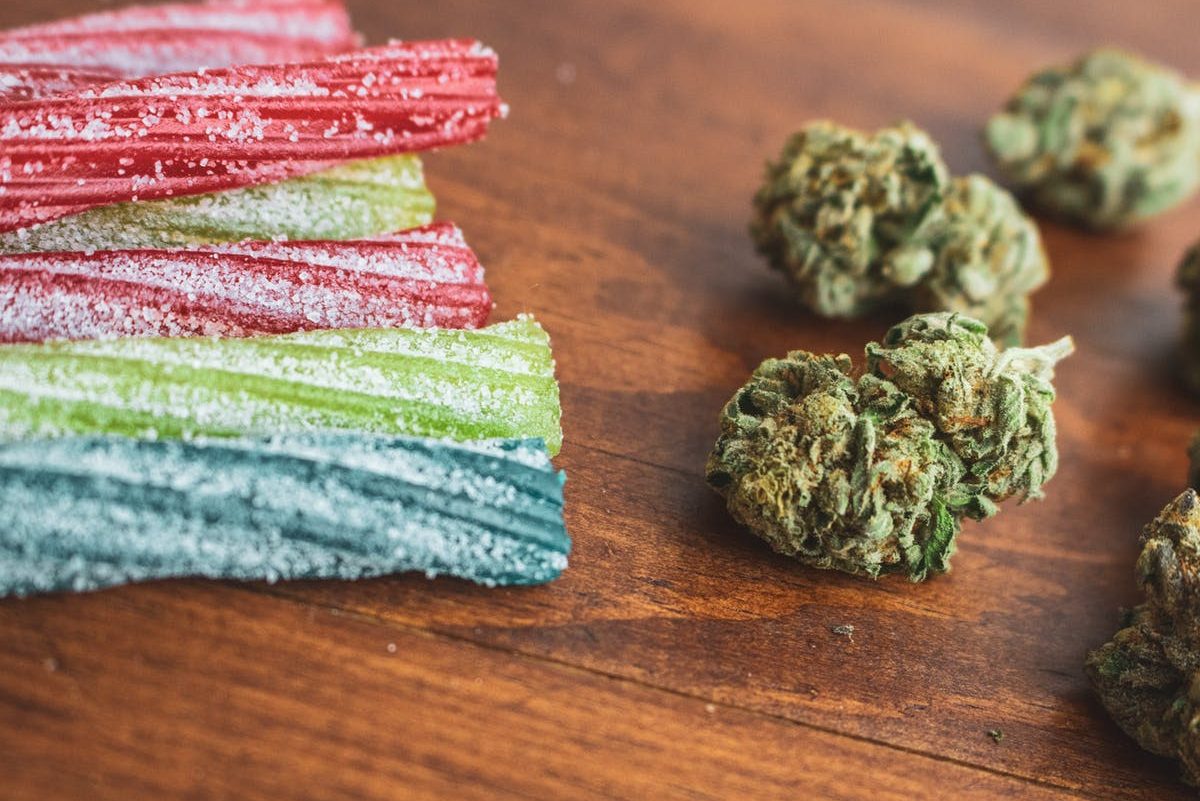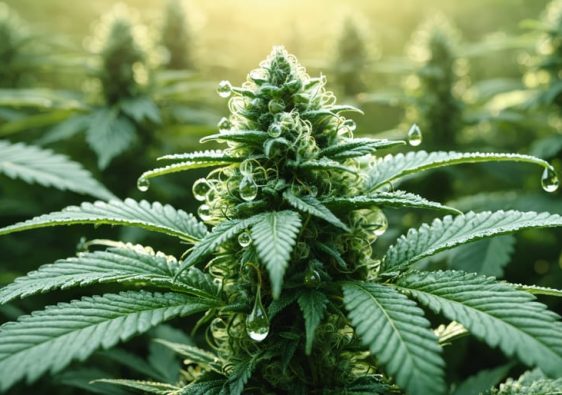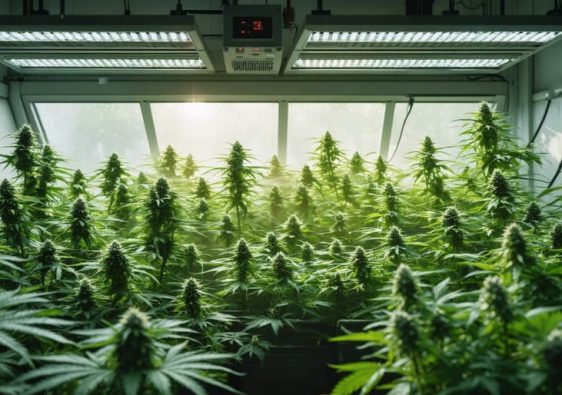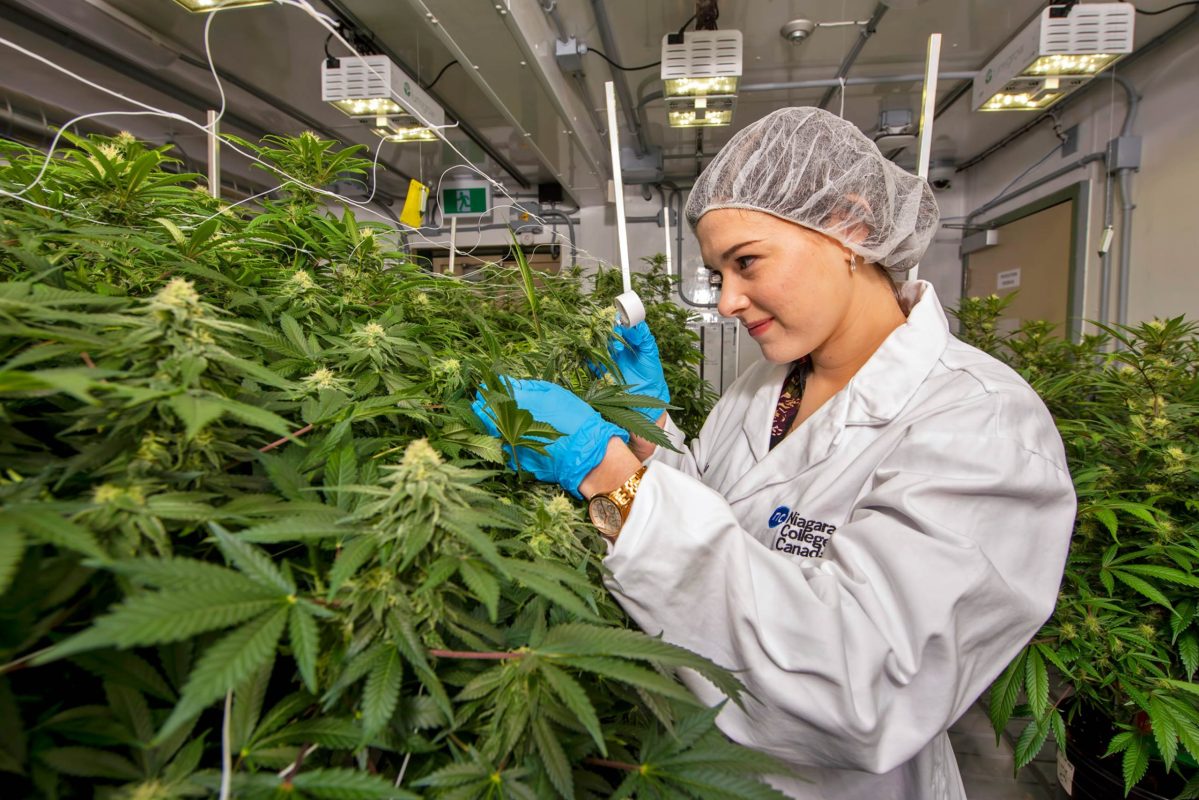Growing weed with LED light isn’t a novel idea anymore. It’s rapidly taking the weed growers and CBD Oil industry by storm. In a few years, it might leave HID lamps in the dust.
Why is LED stealing the spotlight?
Simple; as Danielle from MyCBDStory.ca explains, it’s a more affordable option.
If you are planning to adopt LED for your indoor cannabis plant cultivation? Then this post is a must-read.
This is a detailed guide on how to grow weed with LEDs.
Now, let’s get started.
Benefits of Using LED Grow Lights
LED cannabis grow lights have revolutionized how cannabis is grown. These lights offer a range of benefits that make them the preferred choice of growers worldwide. The perks of using LED grow lights to cultivate weed are as follows.
Energy Efficiency
LED grow lights are incredibly energy-efficient. Unlike traditional HID lamps, which waste a lot of energy as heat, they produce less heat and use less energy. It not only saves on energy bills but also reduces the need for cooling systems, further saving costs.
Customizable Spectrum
It allows growers to customize the spectrum of light their plants receive. That means that cultivators can tailor the light to the specific needs of their plants. Therefore, the plants can receive appropriate light at every growth stage.
This results in better yields, higher-quality buds, and faster growth rates.
Longer Lifespan
LED lighting has a significantly longer lifespan than traditional HID lamps. They last up to 50,000 hours, over five times longer than HID lamps. It means growers can save money on replacement costs and spend more time focusing on growing their crops.
Reduced Heat
These lights produce less heat than traditional HID lamps. That’s because they convert more of the energy they consume into light rather than heat. Thus, you may not need cooling systems, creating a more comfortable environment. Lesser heat also reduces the fire risk, making LED grow lights safer.
Environmentally Friendly
LED grow lights are environmentally friendly. They use less energy and produce less heat than traditional HID lamps, reducing their carbon footprint.
Additionally, it doesn’t contain harmful chemicals like mercury, which is present in HID lamps.
Better Quality Buds
They also provide a full light spectrum, promoting high-quality bud growth. This is because you can customize it to mimic natural sunlight, which is essential for developing terpenes and cannabinoids.
Factors to Consider Before Growing Weed With LEDs
Before embarking on the journey of growing weed with LED lights, there are several factors that growers need to consider to ensure successful cultivation.
Budget
First, you should put your budget into consideration. LED lights can be expensive but cost-effective in the long run due to their energy efficiency and longer lifespan. Therefore, growers must invest in high-quality LED lights that fit their budget.
Spectrum
One of the essential factors to consider before growing weed with LED lights is the spectrum. Different light spectrums are required for different stages of plant growth, such as vegetative and flowering. Hence, growers should choose LED lights with a customizable spectrum to ensure their plants receive the correct light spectrum at each growth stage.
Wattage
The wattage of LED lights is another crucial factor. LED lights wattage determines their energy consumption and the heat they produce.
Growers must choose LED lights with the appropriate wattage to avoid overheating their plants and causing a light burn.
Growing Space
Cultivators factor in the size of their growing space before choosing LED lights. The size of the growing space determines the number of LED lights required to achieve optimal growth.
Additionally, you should also ensure the LED lights fit your growing space and provide even light coverage.
Brand and Quality
The brand and quality of LED lights are also essential factors to factor in before growing weed. There are several brands of LED lights on the market. So, you’ll have to choose a reputable brand that offers high-quality lights. This will ensure that you get the best results from your plants.
Cooling System
LED lights produce less heat than traditional HID lamps but still emit some heat.
Therefore, you should check out your cooling system before choosing LED lights. A proper cooling system will ensure the LED lights do not overheat and damage the plants.
Choosing the Right LED Grow Light for Your Cannabis Plants
LED grow lights aren’t equal. There are 3 variances of LED cannabis grow lights. But each serves different purposes; thus, there’s no best grow light. It all depends on the circumstances or the peculiarity of your needs.
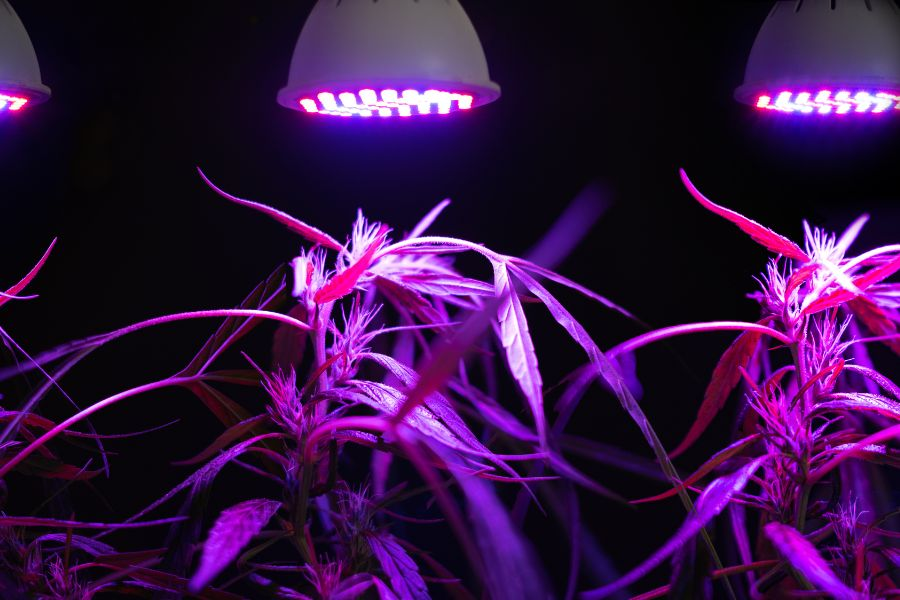
We can’t help you decide on the best LED lights for you. However, here’s a little nudge in the right direction.
Spread Style
This LED type consists of smaller LEDs spread across a large area. Typical examples of spread style are Quantum Board, Spider, and Rack.
Each of these LED lights is the fan’s favorite due to their energy effectiveness. It, therefore, enables cultivators to manage costs. Note that Spider LED could be expensive.
Traditional Panel
The conventional LED panel has compact lamps and small to medium-wattage diodes. This panel style is a pretty common design often used for growing cannabis. The style combines features from Quantum Board and COD style. It comprises several red and blue LEDs and appears “purple.”
Recently, hybrid LEDs have mixed big and small LEDs to create unique styles.
COD Style
A short form for Chip on Board, COD has the brightest light intensity of the three. The bulbs are large and highly potent.
COD contains multiple LED chips fixed on a small portion. That’s why it emits intense light. As expected, it consumes a significant amount of electricity.
LEDs vs. HID for Growing Weed
Two of the most popular lighting for cannabis cultivation are High-Intensity Discharge (HID) lights and Light Emitting Diode (LED) lights.
Each has its advantages and disadvantages. Understanding the differences helps you make an informed decision.
HID Lights
HID lights have been the go-to lighting option for cannabis growers for decades. These lights produce high-intensity light that is ideal for large grow spaces.
HID lights come in two types: Metal Halide (MH) and High-Pressure Sodium (HPS). MH lights generate cool blue light work for the vegetative growth stage, while HPS emit red color lights that benefits the flowering stage.
Advantages of HID Lights
- It provides a high-intensity light ideal for large grow spaces.
- HID lights are less expensive upfront compared to LED lights.
- They have been used for decades, making them a tried-and-true method for cannabis cultivation.
Disadvantages of HID Lights
- HID lights consume a lot of electricity, resulting in higher energy bills.
- It produces a lot of heat, which can lead to temperature management issues and the need for additional cooling systems.
- HID lights have a shorter lifespan than LED lights and require frequent bulb replacements.
LED Lights
LED lights are a newer technology that has gained popularity in recent years. It uses less energy than HID lights and produces less heat. This makes them an energy-efficient and low-heat lighting option for cannabis growers.
Advantages of LED Lights
- LED lights use less energy, lowering energy bills.
- It emits less heat, reducing the need for additional cooling systems.
- LED lights have a longer lifespan than HID lights and require fewer bulb replacements.
- This light emits a full spectrum of light, allowing for optimal growth during all stages of cannabis growth.
Disadvantages of LED Lights
- LED lights are more expensive upfront than HID lights.
- The light intensity of LED lights is typically lower than that of HID lights, requiring more fixtures to achieve the same coverage area.
Which Is Better?
The choice between HID and LED lights ultimately depends on the grower’s needs and budget. HID lights are a tried-and-true method for cannabis cultivation and are a good option for those with large grow spaces and a limited budget.
However, HID lights have higher energy bills, temperature management issues, and frequent bulb replacements. On the other hand, LED lights are more energy-efficient, emit less heat, and have a longer lifespan.
However, LED lights have a higher upfront cost but offer long-term energy and maintenance savings. It’s your call.
Setting Up Your Grow Room With LED Grow Lights
A critical aspect of this process is selecting the right lighting for your plants. However, LED grow lights have become a popular choice for many growers. If you’re interested in setting up your weed grow room with LED grow lights, there are steps you can follow to get started.
Firstly, choosing a suitable space for your grow room is essential. This space should be secure and private, with access to electricity and water. It should also be well-ventilated, with the ability to control the temperature and humidity levels.
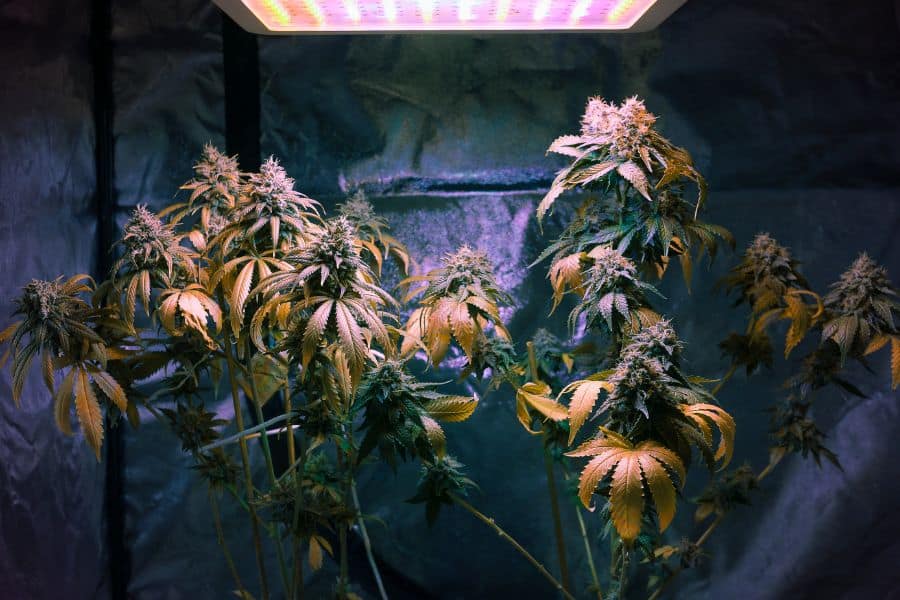
Once you’ve chosen a suitable space, it’s time to install reflective material on the walls. This will help maximize light reflection and ensure the plants receive as much light as possible. You can use white or silver reflective material to cover the walls for the best results.
Next, select the right LED to grow lights for your cannabis plants. This will depend on the size of your grow room, the stage of plant growth, and other factors. LED grow lights are available in various sizes, shapes, and spectrums, so research before purchasing.
Once you have your LED grow lights, it’s time to install them in your grow room. Follow the manufacturer’s instructions carefully, and adjust the height and distance of the lights as necessary. That way, you can make sure the plants receive the optimal light.
As your plants begin to grow, monitoring the temperature and humidity levels in your grow room is crucial. Cannabis plants thrive in specific temperature and humidity ranges, so use a thermometer and hygrometer to keep track of these factors. For instance, too much light makes marijuana plants grow slowly.
You’ll also need to keep an eye on your plants’ nutrient and pH levels. Cannabis plants require specific nutrients and pH levels to grow successfully, so adjust for healthy plant growth.
Setting up a weed grow room with LED grow lights can be a fun and rewarding experience.
Tips for Growing Weed With LED Grow Lights
- Choose the right LED grow lights: When selecting LED grow lights, consider the size of your grow room and the stage of plant growth. Look for LED grow lights with the appropriate wattage and spectrum for your plants’ needs. Despite having less energy, your cannabis may still be susceptible to light burn.
- Determine the right height and distance: The height and distance of the LED grow lights from the plants should be adjusted based on the type of LED grow light used. Too much or too little light can negatively impact plant growth, so following the manufacturer’s instructions is essential.
- Maintain appropriate temperature and humidity: Cannabis plants thrive in specific temperature and humidity ranges. During the vegetative stage, the temperature should be between 65-80°F during the day and 60-70°F at night. During the flowering stage, the temperature should be between 65-80°F during the day and 55-65°F at night. Humidity should be between 40-60% during the vegetative stage and 40-50% during the flowering stage.
- Use appropriate nutrients: Cannabis plants require specific nutrients to grow successfully. It’s essential to use high-quality fertilizers suitable for the plant growth stage. Be sure to follow the manufacturer’s instructions and monitor nutrient levels regularly.
- Monitor pH levels: The pH level of the soil or hydroponic solution should be between 6.0-7.0 during the vegetative stage and 6.0-6.5 during the flowering stage. Monitor pH levels regularly and adjust as necessary for growth.
- Control pests and diseases: Pests and diseases can harm cannabis plants. Use natural pest control methods like neem oil to keep pests at bay. When growing cannabis, you should keep the grow room clean and well-ventilated to prevent the spread of diseases.
- Inspect and prune plants: Inspect plants regularly for signs of stress or disease, and prune them to encourage better growth and maximize yield.
Common Mistakes to Avoid When Growing Weed With LEDs
1. Not Doing Enough Research
One of the most common mistakes when growing weed with LEDs is not doing enough research. It is imperative to understand the different types of LEDs, the spectrum of light they produce, and how to use them properly.
2. Not Understanding the Spectrum
LED lighting systems come in different spectrums, and it’s essential to understand which spectrum is best for growing weed.
Too much of one type of spectrum can lead to stunted growth, while too little of another can prevent the plant from flowering.
3. Not Choosing the Right Size
When selecting LEDs for growing weed, choosing the right size is essential. LEDs that are too powerful or weak will be ineffective, leading to poor growth and flowering.
4. Not Using Reflectors
Reflectors increase the amount of light that reaches the plant and are necessary to grow with LEDs.
Conclusion and Final Thoughts
Growing weed with less can be an excellent option for those looking to save money, reduce their environmental impact, or simply have a smaller growing space.
Implementing the tips and techniques outlined in this article will help you achieve successful cannabis growth with less water, energy, and space.
Remember to choose the right strains for your needs. Invest in quality equipment and regularly monitor plant growth and health.
With some effort and attention, you can enjoy a rewarding and sustainable cannabis-growing experience.

